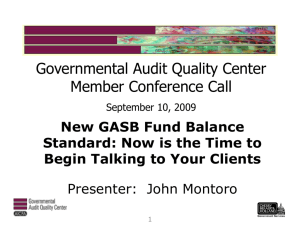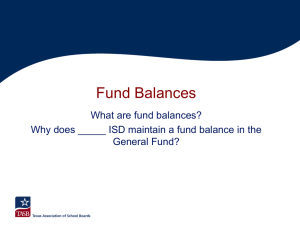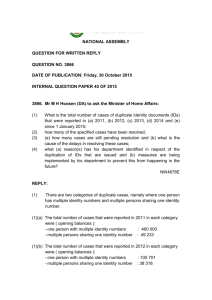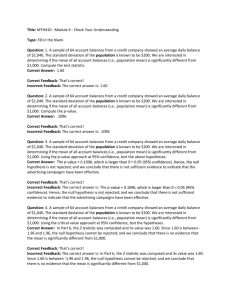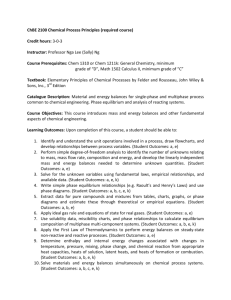Fund Balance Reporting and Governmental Fund Type Definitions
advertisement
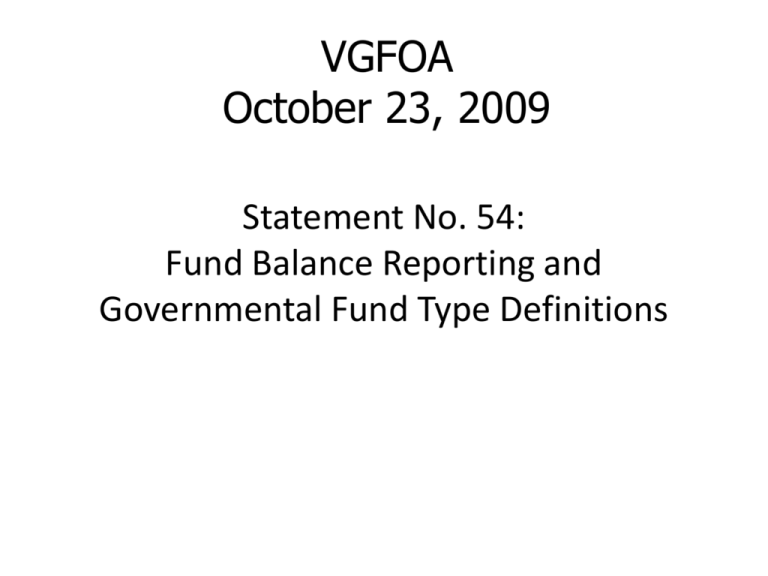
VGFOA October 23, 2009 Statement No. 54: Fund Balance Reporting and Governmental Fund Type Definitions Presenters Bruce W. Chase Professor of Accounting Radford University John B. Montoro Director of Government Services Cherry, Bekaert, & Holland, L.L.P. Objective of today’s discussion • • • • • Background on GASB 54 Fund balance – current standard Fund balance under GASB 54 Fund balance policies Government fund type definitions Statement No. 54 • Approved by the Board in February • Released March 11, 2009 • Effective for periods beginning after June 15, 2010 Origins of the Project • Statement 34 had no effect on fund balance reporting • Significant variation in how standards are applied, leading to significant divergence in practice • Widespread confusion about terminology • Mismatch between what governments are reporting about fund balance and what users of financial statements actually need Fund Balance – Current Standard • What is fund balance? Difference between assets and liabilities Fund Balance – Current Standard • How do we allocate fund balance? Reserved Unreserved • Designated • Undesignated What is the primary objective of allocating fund balance? Fund Balance – Allocation Objective • To isolate that portion of fund balance that is not available for the following period’s budget. Reserved fund balance: – Resources not available for spending in the current year’s budget. – Legal restrictions on spending that is narrower than the purpose of the fund itself. Fund Balance – Allocation Objective Reserved fund balance: – Resources not available for spending in the current year’s budget. – Legal restrictions on spending that is narrower than the purpose of the fund itself. - Inventories - Long term receivables - Prepaid expenses - Encumbrances - Categorical grants (maybe) Fund Balance – Current Standard ASSETS Assets available for spending and not subject to legal limitations LIABILITIES AND FUND BALANCE Liabilities normally expected to be paid from current financial resources Undesignated unreserved fund balance (available for appropriation) Financial assets Designated unreserved fund balance (subject to tentative management plans) Assets subject to legal limitations Unavailable assets (e.g. long-term loans receivable) Reserved fund balance (not available for appropriation Fund balance Fund Balance – Current Standard • Two characteristics of reserved fund balance under the current standard: – Objective is to identify resources that are not available for spending in next year’s budget – Classification depends on whether the restrictions are narrower than the purpose of the fund itself. Effect of the Columns • Under the current standard amounts are classified from the perspective of the column • Consider a government that has – $100 earmarked for capital projects by the government itself – $100 in property tax revenue restricted to paying debt service – $100 of cash available for any purpose Under the current standards If the amounts constrained to specific purposes are reported in the general fund, they are shown as reserved GF SRF DSF CPF Non-major Funds Total Reserved for: Capital projects $100 $100 Debt service $100 $100 $100 $100 Unreserved But… Under the current standards If the amounts constrained to specific purposes are reported outside the general fund, they are shown as unreserved GF SRF DSF CPF Non-major Funds Total Reserved for: Capital projects $100 $100 Debt service $100 $100 $100 $100 Unreserved Under the current standards If the amounts constrained to specific purposes are reported outside the general fund, they are shown as unreserved GF SRF DSF CPF $100 $100 Non-major Funds Total Reserved for: Capital projects Debt service Unreserved $100 This will change… $300 New Fund Balance Classifications Essentially what is now reserved Essentially what is now unreserved • • • • • Nonspendable Restricted Committed Assigned Unassigned Essentially what is now designated Nonspendable Fund Balance • Not in spendable form, such as – Inventory – Long-term receivables (unless the proceeds are restricted, committed, or assigned) • Legally or contractually required to be maintained intact – Corpus of a permanent fund Restricted Fund Balance • Same definition as for net assets in Statement 34 (as amended by Statement 46)—amounts constrained to being used for a specific purpose by – External parties – Constitutional provisions – Enabling legislation Committed Fund Balance • Constraint on use imposed by the government itself, using its highest level of decision making authority • Constraint can be removed or changed only by taking the same action • Action to constrain resources should occur prior to end of fiscal year, though the exact amount may be determined subsequently Assigned Fund Balance • Amounts intended to be used for specific purposes • Intent is expressed by – The governing body – A body (budget or finance committee) or official authorized by the governing body • Residual amounts in governmental funds other than the general fund are assigned • Appropriation of existing fund balance Unassigned Fund Balance • Available for any purpose • Reported only in the general fund, except in cases of negative fund balance – Negative balances in other governmental funds are reported as unassigned Under the new standards The amounts constrained to specific purposes are reported in the same classifications regardless of the fund they are in GF SRF DSF CPF Non-major Funds Total Restricted for: Debt service $100 $100 Committed for: Capital projects $100 $100 Unassigned $100 $100 Or… Under the new standards The amounts constrained to specific purposes are reported in the same classifications regardless of the fund they are in GF Restricted for: Debt service DSF CPF Total $100 $100 Committed for: Capital projects Unassigned SRF Non-major Funds $100 $100 The funds have changed, but the fund balance classifications have not $100 $100 Encumbrances • Encumbrances should not be displayed separately within the restricted, committed, and assigned categories • Amounts are classified as restricted, committed, and assigned based on the source and strength of the constraints placed on them—encumbering those amounts does not further affect them Encumbrances • The Treatment of Encumbrances highlights the key difference between fund balance allocation under the old method and GASB 54 • The concept of an encumbrance is based on budgetary availability – reserving resources that can’t be used for next year’s budget • GASB 54 allocations are distinguished by the extent to which purpose limitations have been established regarding the use of those amounts. Encumbrances • For example, an amount could be classified as restricted for a specific purpose, some or all of which may be encumbered. • Encumbering the amount does nothing to further restrict the amount, so it should not be shown on the face of the statement. Encumbrances – OK, this slide is easier! • If you have encumbrance accounting, encumbrances will be reported either as: – Committed (if encumbrances are approved by action of the highest decision making authority) – Assigned – if the year-end encumbered amount is a result of normal purchasing activity approved by appropriate officials. • This will be the most common classification of encumbrances Level of Detail • Level of detail requirements may be met by display or a combination of display and disclosure – Nonspendable by type – Restrictions by purpose – Commitments and assignments in sufficient detail that major purposes are evident to reader Specific purpose details displayed General Fund Fund balances: Nonspendable: Inventory Permanent fund principal Restricted for: Social services Parks and recreation Education Highways Road surface repairs Debt service reserve School construction Law enforcement Other capital projects Other purposes Committed to: Zoning board Economic stablization Homeland security Education Health and welfare Assigned to: Parks and recreation Library acquisitions Highway resurfacing Debt service Public pool City Hall renovation Other capital projects Other purposes Unassigned: Total fund balances Major Special Revenue Funds Highway School Aid Fund Fund Major Debt Service Fund Major Capital Projects Fund Other Funds Total 16,000 — — — — — — $ 164,000 — — — — 24,000 — — — — — — — — — — — — — — — — — — — — $ 206,000 — — — — — — — $ 444,000 — — 301,000 — 51,000 — — — — — — — — 214,000 — — 240,000 80,000 55,000 444,000 24,000 206,000 301,000 214,000 51,000 30,000 16,000 210,000 110,000 50,000 75,000 — — — — — — — — 103,000 — — — — — — — — — — — — — — — — 16,000 210,000 110,000 153,000 75,000 50,000 50,000 — — — — 50,000 80,000 525,000 $ 1,746,000 — — 258,000 — — — — — — $ 390,000 — — — — — — — 73,000 — 192,000 — — — 306,000 — — — — — $ 512,000 — — — — 121,000 60,000 471,000 — — $ 1,448,000 — — — — — — — 176,000 — $ 554,000 50,000 50,000 258,000 306,000 121,000 60,000 521,000 329,000 525,000 $ 4,842,000 $ 125,000 — $ 108,000 — 240,000 80,000 55,000 — — — — — — 30,000 $ $ $ 249,000 164,000 This level of detail is not required for display on the face of the balance sheet. Fund balance categories and classifications may be presented in detail or in the aggregate if sufficient detail is provided in the notes to the financial statements. Classification totals displayed—details disclosed in the notes General Fund Fund balances: Nonspendable Restricted Committed Assigned Unassigned Total fund balances $ 125,000 405,000 461,000 230,000 525,000 $ 1,746,000 Major Special Revenue Funds Highway School Aid Fund Fund $ 108,000 24,000 — 258,000 — $ 390,000 $ $ 16,000 — 103,000 73,000 — 192,000 Major Debt Service Fund Major Capital Projects Fund Other Funds — $ 206,000 — 306,000 — $ 512,000 — $ 796,000 — 652,000 — $ 1,448,000 $ 164,000 214,000 — 176,000 — $ 554,000 Total $ 413,000 1,645,000 564,000 1,695,000 525,000 $ 4,842,000 Classifying Residual Balances • Spending prioritization policies (the flow assumption) – Restricted vs. unrestricted – Committed, assigned, unassigned – Multiple policies – The “default” policy – Negative balances • General fund • Other funds Classifying Residual Balances • The flow assumption for this special revenue fund is to use restricted amounts before unrestricted amounts and to use the default policy for its unrestricted fund balance. If expenditures incurred exceed the amounts that have been restricted, committed, and assigned to a specific purpose and results in a negative residual amount for that specific purpose, amounts assigned to other purposes in that fund are reduced to eliminate the deficit. What were the balances at the beginning of the year? Purpose A Beginning Balances Additions Expenditures Incurred Ending Balances Purpose B Beginning Balances Additions Expenditures Incurred Ending Balances Purpose C Beginning Balances Additions Expenditures Incurred Ending Balances Total 5,696 Restricted 2,000 Committed 2,616 Assigned 1,080 8,871 8,871 0 0 8,040 0 0 8,040 Were additional amounts restricted, committed, or assigned? Purpose A Beginning Balances Additions Expenditures Incurred Ending Balances Purpose B Beginning Balances Additions Expenditures Incurred Ending Balances Purpose C Beginning Balances Additions Expenditures Incurred Ending Balances Total 5,696 Restricted 2,000 Committed 2,616 Assigned 1,080 8,871 1,500 8,871 0 0 1,500 8,040 120,000 0 0 120,000 8,040 How much was spent for each purpose? Purpose A Beginning Balances Additions Expenditures Incurred Ending Balances Total 5,696 Restricted 2,000 Committed 2,616 Assigned 1,080 (2,616) 0 (1,080) 0 (7,654) (1,958) (2,000) 0 Purpose B Beginning Balances Additions Expenditures Incurred Ending Balances 8,871 1,500 (10,000) 371 8,871 0 (8,871) 0 0 Purpose C Beginning Balances Additions Expenditures Incurred Ending Balances 8,040 120,000 (11,223) 116,817 0 0 0 120,000 (11,223) 108,777 0 1,500 (1,129) 371 8,040 8,040 Unassigned (1,958) (1,958) What happens to a negative balance? Purpose A Beginning Balances Additions Expenditures Incurred Ending Balances Total 5,696 Restricted 2,000 Committed 2,616 Assigned 1,080 (2,616) 0 (1,080) 0 (7,654) (1,958) (2,000) 0 Purpose B Beginning Balances Additions Expenditures Incurred Ending Balances 8,871 1,500 (10,000) 371 8,871 0 (8,871) 0 0 Purpose C Beginning Balances Additions Expenditures Incurred Ending Balances 8,040 120,000 (11,223) 116,817 0 0 0 120,000 (11,223) 108,777 Unassigned 0 1,500 (1,129) 371 8,040 8,040 If this were the general fund, unassigned fund balance would be reduced. (1,958) (1,958) Classifying Residual Balances • . In case A, the government elected a policy where restricted amounts are used before unrestricted amounts. The government did not elect a policy on the use of unrestricted amounts, therefore the default is used. • In case B, the government elected a policy where unrestricted amounts are used before restricted amounts. The government also elected a policy that assigned amounts are used before committed amounts. Special Revenue Fund Order of Spending Policy Case A Order of use: Restricted, default Total Beginning balance Restricted Committed Assigned 10,000 4,000 4,000 2,000 Expenditures 7,000 4,000 3,000 0 Ending Balance 3,000 0 1,000 2,000 Case B Order of use: Unrestricted, assigned, committed Total Beginning balance Restricted Committed Assigned 10,000 4,000 4,000 2,000 Expenditures 7,000 1,000 4,000 2,000 Ending Balance 3,000 3,000 0 0 Fund Definitions - General Fund • General Fund: used to account for all financial resources not accounted for in another fund No changes here. Special Revenue Funds Current Definition: • Special Revenue Funds —To account for the proceeds of specific revenue sources (other than trusts for individuals, private organizations, or other governments or for major capital projects) that are legally restricted to expenditure for specified purposes. Special Revenue Funds Statement 54 Definition: Special revenue funds are used to account for and report the proceeds of specific revenue sources that are restricted or committed to expenditure for specified purposes other than debt service or capital projects. The term “proceeds of specific revenue sources” establishes that one or more specific restricted or committed revenues should be the foundation for a special revenue fund. Special Revenue Funds • Report specific revenue sources restricted or committed to specified purposes other than debt service and capital projects • Restricted or committed specific revenue sources should comprise substantial portion of fund’s resources, but fund also may include other restricted, committed, and assigned resources • Disclosure: purpose of each major special revenue fund and each revenue source or other resources reported in each Special Revenue Funds • Which definition appears more restrictive – Old or New? OLD ! Legally restricted vs Restricted or committed Special Revenue Funds • So why should there be attention and (concern?) focused on the GASB 54 definition? No one was paying attention to the old definition! Effect of SRF Clarifications Current Standards Less restrictive Current Practice More restrictive New Standards Special Revenue Funds under GASB 54 • If revenues are initially received in another fund, they should NOT be reported as revenues in the fund receiving them; instead, they should be recognized in the special revenue fund where they will be spent. • The proceeds from these special revenue sources should be expected to continue to comprise a substantial portion of inflows. • Governments should discontinue reporting a special revenue fund, and instead report the resources and expenditures in the general fund, if the government no longer expects that a substantial portion of revenues will be derived from restricted revenue sources. Special Revenue Fund Examples • The following slides summarize information from the combining statement of revenues, expenditures and changes in fund balance for special revenue funds • • • Does the fund meet the GASB 54 definition of a Special Revenue Fund type?? If not, what should happen to it? If your answer is “it depends” tell me what additional information you need. GASB 54 – Is it a Special Revenue Fund? City of Veranda: Combining Schedule - Special Revenue Funds Golf Courses Revenues: Property taxes Charges for services Investment income $ Expenditures $ 2,487,355 183,386 2,298,791 Transfers in (out) Fund balance, beginning Fund balance, ending Town Center Special Service District (200,000) $ 321,525 493,475 $ 1,274,196 43,448 934,828 1,146,878 1,529,694 GASB 54 – Is it a Special Revenue Fund? City of Veranda: Combining Schedule - Special Revenue Funds Tourism Advertising Program School Reserve Revenues: Property taxes Charges for services Investment income $ - $ 472,097 58,150 Expenditures - 9,926,052 Transfers in (out) - 9,100,314 Fund balance, beginning Fund balance, ending $ 4,344,063 4,344,063 $ 946,923 651,432 GASB 54 – Is it a Special Revenue Fund? City of Veranda Combining Schedule Aquarium and - Special Revenue Funds Marine Science Center Major Projects Revenues: Property taxes $ $ Charges for services 6,124,748 Investment income 22,384 1,129,400 Expenditures 7,130,383 Transfers in (out) 1,010,272 Fund balance, beginning Fund balance, ending $ 122,637 149,658 $ 343,127 (1,384,602) 28,417,958 27,819,629 Special Revenue Funds Exercise • 10 Funds need to be reviewed out of 33 total 31% Something to consider before you decide to early implement GASB 54…. Special Revenue Funds Exercise • If you want to be ready to implement GASB 54 for the fiscal year ending June 30, 2011, when should planning begin? At the beginning of your FY 2011 budget cycle – the Fall of 2009!! Special Revenue Funds • Disclosure: purpose of each major special revenue fund and each revenue source or other resources authorized to be reported in each. • Final point: This is a financial reporting standard. • It does not require you to collapse all these funds in your general ledger. Capital Projects & Debt Service Funds • Text made consistent with other definitions • Capital projects fund definition is more reflective of current practice • Highlighted that debt service funds are required when – Legally mandated – Financial resources are being accumulated for principal and interest payments maturing in future years Capital Projects and Debt Service Funds Prior Definitions: • Capital projects funds—to account for financial resources to be used for the acquisition or construction of major capital facilities (other than those financed by proprietary funds or in trust funds for individuals, private organizations, or other governments). • Debt service funds—to account for the accumulation of resources for, and the payment of, general long-term debt principal and interest. Capital Projects Funds Statement 54 Definition: • Capital projects funds are used to account for and report financial resources that are restricted, committed, or assigned to expenditure for capital outlays, including the acquisition or construction of capital facilities and other capital assets. Capital projects funds exclude those types of capital related outflows financed by proprietary funds or for assets that will be held in trust for individuals, private organizations, or other governments. Debt Service Funds Statement 54 Definition: • Debt service funds are used to account for and report financial resources that are restricted, committed, or assigned to expenditure for principal and interest. Note Disclosures • Description of authority and actions that lead to committed and assigned fund balance • Government’s policy regarding order of spending – Restricted and unrestricted fund balance – Committed, assigned, and unassigned • Encumbrances, if significant, are disclosed in conjunction with other disclosures of significant commitments Note Disclosures • Stabilization arrangements – Authority for establishing – Requirements for additions – Conditions under which amounts may be used • Minimum fund balance policies GASB 54 Summary – What to do? • GASB 54 will be here sooner than you think! – Review fund structure – Review/establish fund balance policy – Be sure that appropriate Board action is taken to ensure funds can be shown as committed – Establish/strengthen control processes to track changes in committed and assigned funds • Appreciation is expressed to the Governmental Accounting Standards Board for permission to use selected materials from its library of public educational presentations. • Official positions of the GASB are determined only after extensive due process and deliberation and are only published in its formal Statements and Interpretations. Questions?
